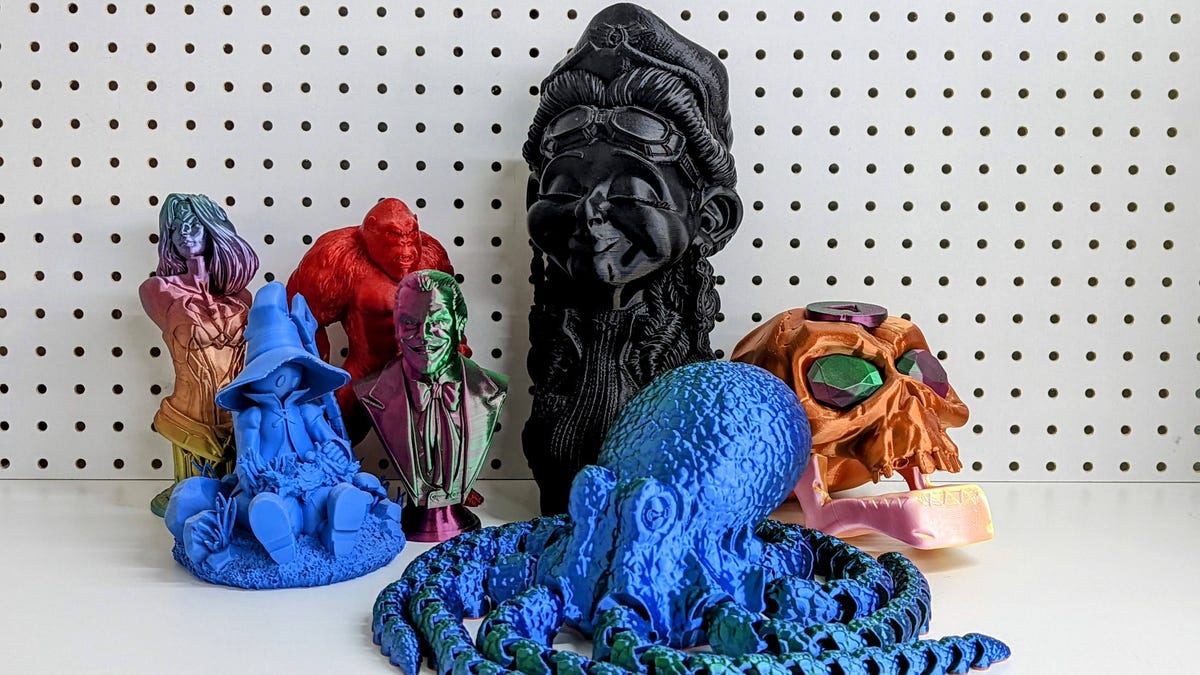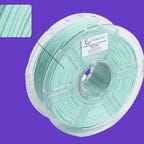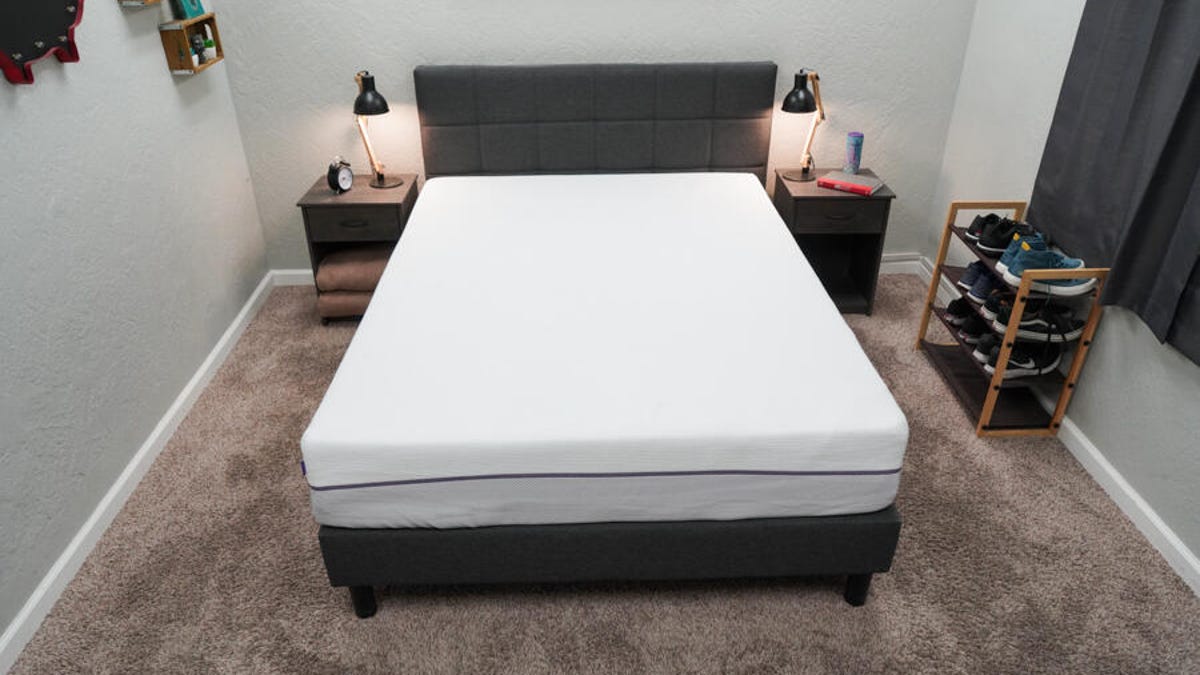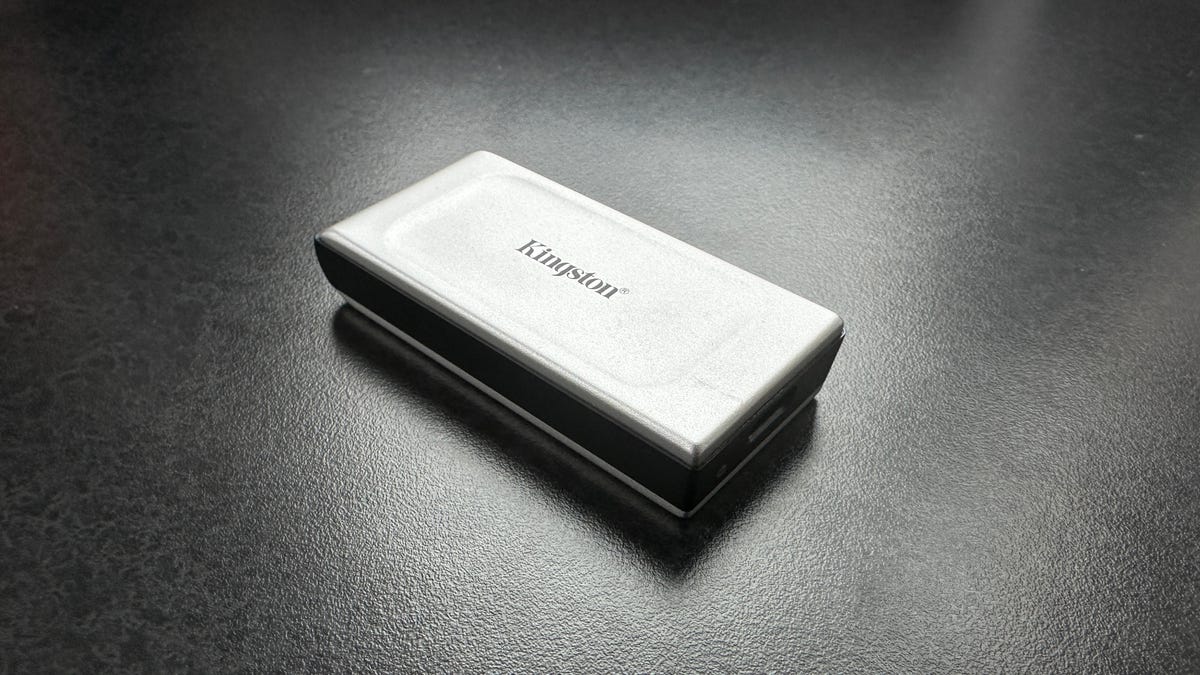Best 3D Printing Filament in 2023: PLA, ABS, PETG and more

Flashforge Burnt Titanium PLA
The best metallic look ever

CookieCad Mint chip
It’s ice cream that won’t melt!
Creality short transition rainbow PLA
So many colors!
Overture PETG Filament 2-pack
Stock up on your PETG
Amolen PLA Filament Glow in The Dark Multicolor PLA
Get a good glow on!
You’ve got the best 3D printer you can buy all set up and ready to go, but you can’t get started without some material. If you chose a fused deposition modeling, or FDM, printer — the most common type of 3D printer for hobbyists — you’ll need a few rolls of special plastic.
The material we use for FDM 3D printing is called filament and it’s an easy material to pick up. There are, however, different types of filament, each good for certain projects and terrible for others. You’ll want to make sure you’re using the best filament for the job at hand, or it may fail.
I’ve put together this primer of the different types of filament as well as choices of the best filaments from my favorite brands. This will be updated regularly and contains some great choices for you to start.
It’s important to choose both the right type of material and the right brand of that type, be it PLA, ABS or something more exotic. Here are the best of each of the five main filament types.
Read more: Best 3D Printers
PLA is the easiest material to use to make awesome things.
Polylactic acid
Polylactic acid, or PLA, is the most common 3D printing filament and the easiest to use. Unlike most plastics, it’s made from corn starches so it is non-toxic and, in theory, compostable, though it takes an industrial composter to do it. PLA uses a fairly low heat — between 190 and 215 degrees Celsius (or between 374 and 419 degrees Fahrenheit) — to melt the plastic for extrusion so it is the safest of the filaments. Almost every FDM 3D printer in the world can print PLA.
PLA pros
- Nontoxic
- No awful smell
- Easy to use for a beginner
- Almost universally usable on any FDM printer
- Very cheap
PLA cons
- Can require a lot of sanding
- Can easily warp in the sun or high-temp environments
- Can be brittle
Build PLA from MatterHackers is great for projects that require finishing (sanding, painting and so on). I have about 12 rolls of it in my workshop, and use it for large projects, including my Mandalorian armor or cosplay swords. The dimensional accuracy — how consistent the diameter is along the length of the roll — is good, though nothing mind-blowing. It’s well within the sweet zone.
Post-processing is where Build Series PLA shines. It is simple to sand and holds paint well, as long as you use a good primer and filler first. Like all PLA, it holds together well using superglue and even takes putty and Bondo without complaint.
The color of this PLA is hard to describe, but it is beautiful. It has a purple-blue-green hue to it and looks like metal that’s been heated up a lot. Right now it’s probably my favorite-looking filament on my shelf.
It’s also easy to print with, and because of the shifting colors it hides layer lines well. If you’re looking for a dark filament that you aren’t painting over, I’d pick up a few rolls of this today.
For something completely different in the PLA world, check out Quantum by MatterHackers. Transitional filament, mixing multiple colors, has been around for a while, but it normally changes color across the length of the material. This causes it to change color as it goes further up the model.
Quantum is actually two colors fused across the entire width, so you get an amazing transition from left to right. It’s absolutely mesmerizing, and I love using it for all sorts of different projects. From vases to giant articulated octopuses, it makes any model look breathtaking.
I have been meaning to buy some of this beautiful filament for some time now, and I’m really happy I did. The color is almost exactly the same as Mint choc chip ice cream and the tiny flecks of marble color enhance the look even more. It prints great, with a nice glossy finish, and I found printing it at a higher temperature brings out that gloss really well.
More importantly than the print quality though, I love it for the way it makes me feel. The color just makes me happy and reminds me of days at the beach with my kids. It’s gorgeous.
Ataraxia Art already makes excellent PLA and flexible PLA but its new range of tri-color filament is some of its best yet. Tri color uses three colored filaments along its width to create a beautiful shimmering effect as you move the model so it’s perfect for projects you aren’t going to be painting.
This PLA comes in four different color combinations and it’s now one of my favorite filaments to use.
Rainbow filament tends to transition between colors very slowly. This means you often get only one or two colors per model. Creality’s latest rainbow filament has a much shorter transition, so you get a much nicer rainbow effect across your models. It looks great on this amazing dragon from Fotis Mint.
For projects you can show off without having to paint them first, PolyTerra might be for you. The colors are vivid, and because they are matte, you don’t lose details in the reflections like with shiny filament.
PolyTerra also comes in recycled cardboard reels, and the creator, Polymaker, will plant a tree in the area where the roll was bought to help offset the cardboard used. This filament is still plastic of course, but it helps my conscience to use it.
In this article about this flexible PLA I explained how, although this isn’t technically PLA, it does print much easier than TPU, a more common flexible filament. I used it to print an amazing Mandalorian Blacksmith helmet for my 4-year-old. She can’t break it because it’s so bouncy.
This isn’t for newbies, though. It took a lot of trial and error to get the setting for my 3D printer right, and because it is so soft the accuracy can be pretty wonky. But for something that’s different from normal PLA, it is worth checking out.
Acrylonitrile butadiene styrene
ABS was one of the more 3D printing filaments a few years back, and it still has some excellent uses. The biggest downside is the toxicity. You don’t want to breathe in ABS as it melts, so you’ll need a well-ventilated area. That aside, it’s sturdier and more heat-resistant than PLA. Most printers can print ABS, but you’ll need a heated bed that can reach 100 degrees Celsius for best results and protecting your printing job in an enclosed printer is a good idea.
ABS pros
- Can withstand a lot of heat
- Easy to sand
- Can be smoothed with acetone for a perfect shine
ABS cons
- Its fumes are toxic so it requires ventilation
- It needs far more heat to print than PLA
- You will need an enclosure to get good results
Inland makes good filament across the board and its ABS is no different. I’ve never had issues with the dimensions, and the final product has consistent layer lines. Sanding Inland ABS is a joy as the material can be wet-sanded to a smooth finish.
Fillamentum is one of my favorite ABS makers. The colors are always so vibrant, and while it costs a little more than the competition, it keeps that vibrancy even after the model is finished printing. If you’re looking for ABS that you don’t need to paint, Fillamentum is a great place to start.
Polyethylene terephthalate glycol
PETG is chemically similar to the plastic that water and soft drink bottles are made of, and is a great alternative to ABS. It has the heat-resistant properties of ABS without the toxic fumes and can be sanded much like PLA. Most FDM printers that can print PLA can print PETG, though it takes a little more effort to get right.
PETG pros
- Easier to print than ABS
- Holds a finish well
- Easier to store than other filaments
PETG cons
- Requires high temps, which can damage printer parts over time.
This USA-made PETG has an excellent glassy look that is hard to achieve in melted plastic. The aqua color is subtle and gives the appearance of a stained glass window when printed at the high end of its temperature scale.
Printing with it was easy, though the roll is a little big for printers like the Bambu Lab X1, that has enclosed filament system.
The Pro series filament from MatterHackers is a much nicer product than a lot of standard PETG. Yes, it costs a little more, but it’s designed to help reduce some of the issues that filament suffers from. It reduces shrinkage, so the part you make is as close to the part you designed as possible. This is a great material for those who make 3D printed models for a living, rather than a hobby.
Overture PETG is a favorite because it comes in an economical two-pack, making it ideal for multiple or larger jobs. I’ve used a lot of Overture products, including PETG and PLA, and they always print well. I once printed an 11-foot-long Masamune sword using Overture and it came out looking awesome.
Thermoplastic polyurethane
TPU is a flexible material that can make cool rubbery models. Most people use it to 3D print phone cases, but more serious modelers often use it to create connectors or flexible hinges to other materials. It can be a difficult material to work with and is best used on a direct-drive 3D printer such as the Prusa Mk3s, rather than a Bowden printer like the Anycubic Vyper. A direct drive printer places the gears to move the filament directly on the print head, while a Bowden setup has them on the frame of the printer.
TPU pros
- Flexible
- Won’t warp in the heat
- Available in fun colors
TPU cons
- Terrible for making solid prints
- Hard to work with on budget printers
MatterHackers Build Series Materials sit in the perfect balance between usability and cost. Yes, I’ve had failures with the Build Series, but once you get it dialed into your printer, you can make dozens of fun, springy models.
I like to use it to make fun toys for my kid’s preschool as they can be thrown around with no fear of breaking into small, sharp pieces.
Exotic filaments
Exotic filaments are ones that are outside the normal five choices, or interesting variations on those choices. They’re often PLA mixed with carbon fiber or glow-in-the-dark chemicals and something that prints outside the normal parameters of a 3D printer. You’ll often need to upgrade your printer nozzle to use these. It’s advanced stuff, but I wanted to show you my favorite glow-in-the-dark filament, which is fun to print with.
Glow-in-the-dark filament normally comes in a standard “radioactive” green, but this beautiful roll transitions through multiple colors. It’s simply gorgeous.
It’s also worthwhile to buy some replacement brass nozzles for your printer as glow-in-the-dark filament can chew them up pretty quickly because the glowing material is more abrasive than standard colors.
Filament FAQ
What filament should I start with?
If you’re buying a printer for the first time, the best choice of filament is PLA. It is the easiest to print with, the safest in terms of fumes and the most readily available. Think about laying in a store of PLA when you first start. A 1-kilogram roll feels like a lot, but once you get the itch, materials get eaten up quickly.
Are there different sizes of filament?
Yes. There are two main thicknesses of filament and if you get them mixed up, your machine won’t print.
1.75mm filament is the most common. It’s been adopted by most of the 3D manufacturers in the world and if you have an entry-level printer, it’s likely to run on 1.75mm filament.
Some 3D printers still use the thicker 3mm style, though, so make sure you know which one yours uses before you spend a lot of money on the wrong material.
When 3D printing with any filament, it is important to remember that you are essentially burning plastic. Inhaling that kind of thing is never going to be good, but not all filaments are equally bad.
Of the four main filament types, ABS is easily the most toxic. You shouldn’t think about printing it unless you have a well-ventilated space away from your day-to-day living spaces. I have a workshop with a full ventilation system and the fumes can still be pretty bad.
Both PLA and PETG are considered nontoxic, though you still want to keep your area ventilated as you use them. Both filaments are safe to print inside your home and while the fumes can smell pretty bad, they’re not classed as carcinogenic. While other forms of TPU can be toxic, the filament you use for 3D printing is considered nontoxic and nonreactive so you should be fine printing that as well.
Does the filament keep the same color after printing?
Normally yes. If your printer isn’t calibrated well, it could burn the filament, which would discolor it. But normally the color accuracy is pretty close.
A special note on clear plastics: You will not be able to get a completely translucent print with filament. The nature of the printing process makes any clear plastic misty and infill makes it blurry as well. If you are looking to print glass-like models, you will need a resin printer.
Having the right diameter makes for a better print.
How we test filament
The testing of filament is mainly focused on a few details: Dimensional accuracy, winding precision, and printing quality. Winding precision is a visual test where I check to make sure the filament works well on the spool, without any crossovers that can cause snags while printing.
Print quality is done using a CNET calibration test that I use to test all of the 3D printers I review. When checking for filament quality, I’m looking for noticeable roughness and missing filament where moisture or other contaminants have interrupted the process of melting and cooling.
Dimensional accuracy is perhaps the most important test as it measures the consistency of filament. As you move along, the filament changes in diameter will cause the 3D printer to over- or under-extrude filament. This creates noticeable scarring in your model, or worse, complete failure. You want the material to have the same diameter the whole way through.
To measure the accuracy, I take a 5-meter piece of filament from the beginning, middle and end of the roll and measure the diameter at four equally spaced points. I then add all of those measurements up and divide the total by 12 — the total number of measurements taken — to give me an average across the roll. Most modern printers use 1.75mm filament so you want the filament to be as close to that as possible.
Great filament has a variance of +/- 0.02mm, good filament is +/- 0.03mm and rough filament is anything +/- 0.05mm. All of the filaments we have recommended here are at least 0.03mm on average.
Source: CNET














